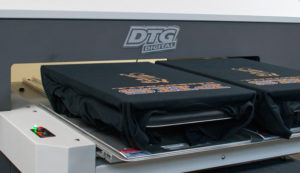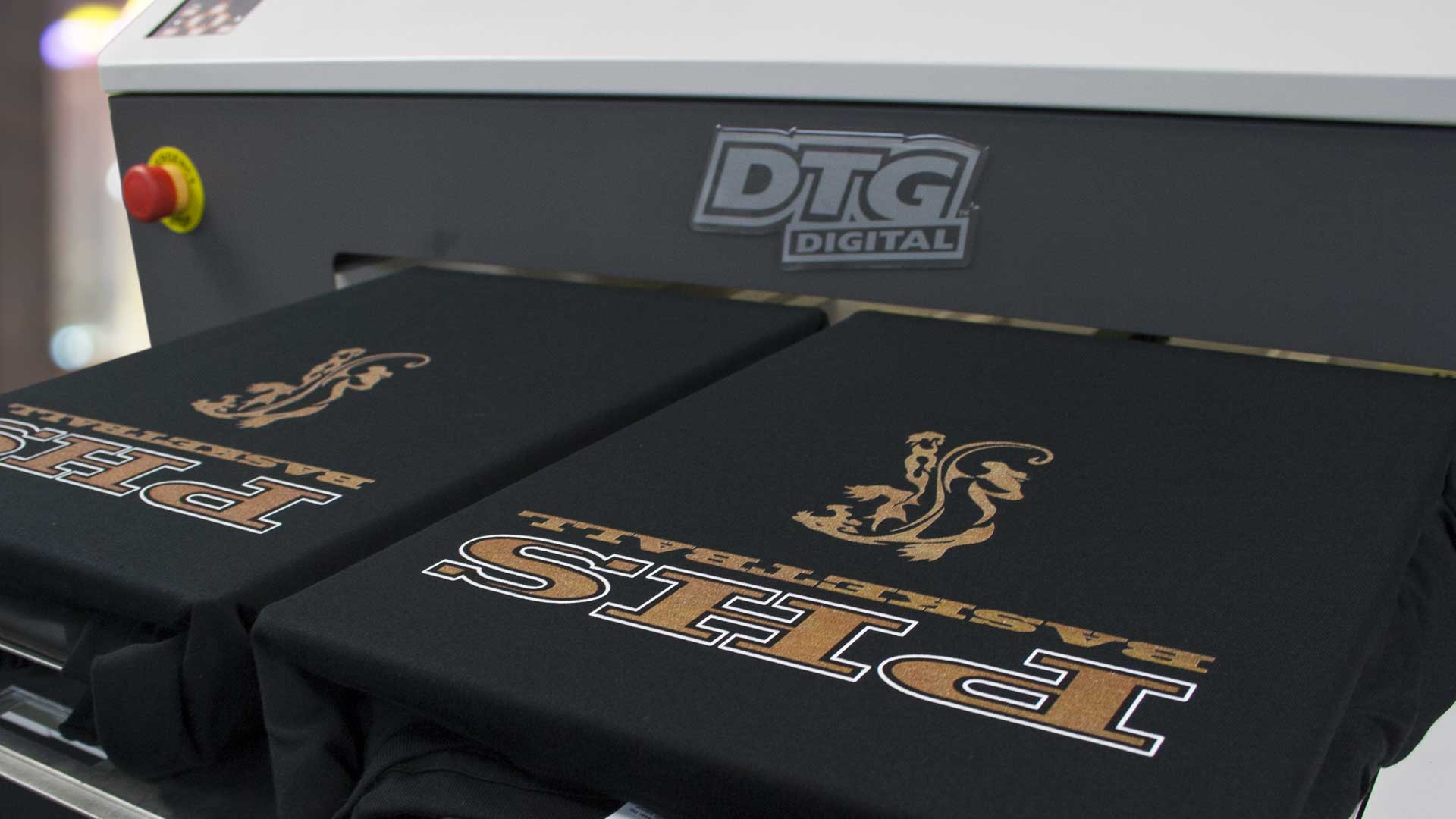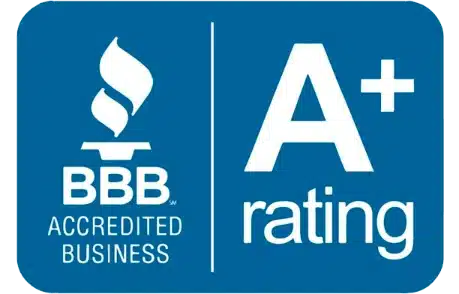Guest: DTG Guru, Heath Schumacher

Episode 23 – Biggest Mistakes Starting a T Shirt Business
What we’re going to talk about today is the custom t-shirt business and custom apparel, and the biggest mistakes in starting a business, specifically with Direct to Garment Printing. A while back we did a Podcast on Mistakes in the Embroidery Business, and we want to expand on that and talk about DTG.
To help us out we chatted with Heath Schumacher, a DTG technician, salesperson, and business owner.
First, we want to talk about the basic mistakes you make in any business. This will especially help those who are starting a brand new custom apparel business.
Going from idea to selling, with nothing in between
There’s no preparation for starting the business. They decide they want to start a business, and just buy a machine. They haven’t thought about whether they want to be a corporation or sole proprietor. Or how they’re going to handle bills and accounting. They don’t have a bank account.
A lot of it is just educating yourself on the basics of what do you need to start a business in your state (specifically). These are things that are worth some time and money to get someone to consult with you on. There are even some states that won’t let you run a DTG printing business from your home, and you need a special license to do so, and this is something you need to know before you start.
Thinking you can wear every hat
This is thinking you can do all the production, artwork, sales, marketing, administration, billing, etc. yourself. There are only so many hours in a given day that you can get things done. So you need to be able to delegate things to people below you as your business grows, and this will be a huge benefit to keep the company running and be profitable at the same time.
We’ve seen people buy a DTG printer but not understand how to create art. The machine doesn’t create the images for you.
We have a blog post that talks about the E-Myth, and in it, we discuss creating a list, and description for all the jobs in your business. What is someone in charge of administration going to do? What is someone in sales going to do? Etc. Even if at the beginning of your business, you’re doing all those roles, when you do decide to hire someone you know exactly what they’re going to be responsible for.
And understand that these don’t have to be full-time employees. Perhaps you work with a freelance artist to create your designs or have a CPA do your bookkeeping once a month, or hire someone to build your website.
Do you have the money to do that?
One of the biggest things that can kill a business is cash flow. From things as simple as ordering business cards, to the bigger supplies. But it’s also knowing that if you get a reasonable sized order, you’re going to have the ink, cleaning supplies, and be able to get the t-shirts without putting yourself into a position where you’re constantly juggling money.
While custom apparel businesses can and are very profitable for some people, they don’t’ always start that way. So if you quit your job to start a DGT business, you still need to think about how you’re going to pay your bills for the next month. You can’t expect that your business will. Do you have enough money in the bank so you can get started?
One of the biggest challenges with cash flow is getting those initial orders. Spending the time to get out to other businesses and talk to people. Because that’s what a lot of the business is about, extending out to other businesses. If that machine’s not running you still have to make those payments, so you need to get out there to create those jobs, but once you have those jobs and you’re making the shirts, no one’s out there to get the next jobs.
The reality is, you should be able to run your business for 90 days, without making a dime. This gives you the time to find those customers, to figure out how to create a profitable t-shirt, to work on the team you need, build up your referral business. By doing this you increase the probability of long-term success. The goal is obviously to make money during that time, but it shouldn’t be that you HAVE to.

Manage your day
Especially if you’re taking on all those roles, you’re going to want to set yourself a schedule to do a little bit of everything each day. Perhaps you set aside half an hour in the morning to watch some graphic design videos to help you make better designs. Or an hour to listen to podcasts that can help you start up your custom apparel business. And every day from 1-2 you’re either making calls or going out to nearby businesses. Then in the rest of the afternoon perhaps you’re practicing on the DTG machine.
It can be hard to set yourself a schedule, especially if you’re working from home, but it’s really important in order to manage and grow your business. And even if you’re established and you suddenly get a large order that would throw your schedule off, you have a better idea of where your time goes, so you can adjust.
The wave
This is where your production is light, so you go out and make sales calls, and perhaps you get a few orders, so you’re busy for the next three days, but then you have nothing to do for the next few days because you haven’t made any sales calls. This will make your income fluctuate. So unless you have a team to help you out with either sales or creating shirts, you’re going to have this up and down trend.
If you want to avoid this, you may need to get creative about your marketing. Use your friends. Word of mouth can be a powerful thing.
Over promising
Never promise something to a client that you can’t produce. It’s better to under promise, and over deliver.
We’ve heard stories of businesses overnighting deliveries in order to get it to the customer on time, because they promised the products by a certain date, without even knowing if it was possible for them to complete it on time. This causes the business to scramble, to work overtime, and potentially not earn any profit off the order because you end up spending a lot more than you budgeted for shipping.
You want to say yes, but you can put yourself into a situation you can’t get out of.
For any new business, we highly recommend reading our two blog posts on knowing your numbers: The Value of a Customer and the Theory of Buying Customers. And it’s not about having a perfect spreadsheet – it’s about understanding the customer’s worth and their lifetime value.
Now let’s get into DTG businesses specifically.
“I have to get my DTG printer delivered by next Tuesday because I’ve got a job due on Wednesday”
When we get an order like this we start asking questions: do you have the artwork already done, do you have the blanks already done, have you been trained on this type of equipment, do you understand the nuisances of setting everything up to make a nice quality product. And most people can barely answer these. You have to give yourself time to learn a new piece of equipment, up and down so you can produce a quality product.
Crawl before you walk.
Learn what’s easier, what’s going to be harder. Talk to a sales associate, because they’ll be able to tell you things like “Printing on a white cotton t-shirt is easier than on a mix-blend colored shirt.” One will take more training to do than the other.
Don’t get the order before you get the equipment. While you may think this makes financial sense – you’ve already got a guaranteed income to help pay for the new equipment – from a technical standpoint, you can learn a whole new piece of equipment in a few days. The only way we would recommend this is if you put a caveat into the agreement – “I can deliver it in 30 days”. A secondary option (if they need the delivery sooner) might be to outsource the order. You still get the order to the customer, and because you know you’re likely to get repeat orders, you can buy the printer and have time to learn it. Because the only thing the customer cares about is the end product – how the product looks – they don’t care how you got it done.

Create a network
Talk to people already in the business. Heath Schumacher contracted business that wasn’t after the same geographical market (so they weren’t competing for business). By contracting out screen-printing shirts, and purchasing them at wholesale, he may only make $1-2 on each shirt, but at the same time, he’s not standing over a printing making them all day. Especially if it’s a small order that doesn’t make it worthwhile to invest in a new machine. And often those screen-printing businesses would send orders back from their customers for DTG printing.
Using equipment without being trained
Don’t just open the box and think you can figure it out. And not just read the directions – get training.
For Heath and his customers, it can be a 2-3 month training process, where he talks to them on the phone 3 times a week, and then slowly less and less. Because often at first it’s about the machine not doing exactly what they want it to do, and it takes training to understand what tools they have – software, mechanical, graphics – that they can use to get a certain desired effect. “Those are the learning curves and the heartaches people have to go through when they’re first starting out.”
Thinking you know it all
It doesn’t matter if you’ve run printers since you were little. Each printer is different. And related to this, is not asking questions, because you think you know the answers. Ask questions, and if a technician gives you advice, follow it. By asking questions you can avoid making mistakes and being frustrated.
Taking advice from other parties too seriously
What we mean by this is, for example, somebody else used to own a printer, (but is not someone who’s a trainer or technician), or they own a different printer, and they tell you “no, don’t pre-treat the way they show you in the video, that’s a waste of time, this is how you want to do it.” What you get yourself into is doing a technique that maybe works for that person, but perhaps they don’t care if the white layers are completely opaque, and that’s how they sell it, and their customers accept it. And now you’re having issues because you’re not getting the white layer you want, but you’re not pre-treating according to the instructions provided by the manufacturer.
Perhaps the person has an older or different machine that they’ve maintained and they’ve tried different inks and found things that worked great for them. When they give you advice, they’re doing it from a good place, but your machine is completely different.
It’s good to take advice from others, but when it conflicts with what the person who is training you has said, you may not want to take what they say too seriously.
Waiting until you’re almost out of supplies to reorder
If you wait until you get an order, to get supplies to fill that order, you’re going to be stressed, and probably pay a lot more to get those supplies rush delivered to you. And there are so many external factors that could delay your shipment. You should have enough cleaning solution, and flushing solution, and ink and pre-treat, to do your jobs and maintain your machine. Shelf life on a lot of these supplies can be fairly long. Ink has a shelf life of 6 months. “Always have a back-up for your back-up.”
Even if you have to toss out, say, 10% of your pre-treat, it would cost you less than if you were to run out of it, and have to rush order it.
Not maintaining your equipment
Even if you have a long day of printing, you should always factor in the time to clean your machine. If your day ends at 6 pm, you should stop printing at 5:30 so you have the time to do your maintenance. If you don’t, when you come in the next day, you’ll have dried, congealed ink all over those parts, and they rub across your nozzle surfaces and now you’re having mechanical, more expensive problems because you didn’t do the simple stuff beforehand. This is preventative maintenance.
And all of these things might not manifest themselves as issues right away. You might be fine for a few days. Or if you only do your maintenance ever other day, your machine might continue to run, but the parts may not last as long.
Leaving your equipment in a box
You bought your machine 3 months ago, but you didn’t have any jobs yet, or time to do training on it, so you’ve left it in the box. There are environmental issues that could affect the machine before you even get a chance to use it.
It’s not terribly difficult to maintain. However, this is a craft that you’re learning, just like anything else. There’s a learning curve for all of it. You’re going to pick up some things faster than others. Take time to learn it.
- Join us on Facebook: Custom Apparel Startups
- Listen to more podcasts: caspodcast.com
- Watch some sales and business webinars: caswebinars.com
- Learn more about Rhinestone Machines, Embroidery Machines, Direct to Garment Printing and more at coldesi.com









